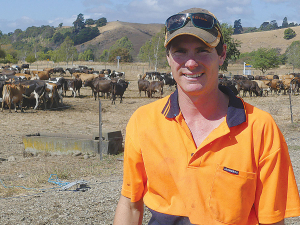 The only dairy farmer forced off his farm by the massive Tasman fire has been able to continue milking despite earlier believing the farm would be too damaged.
The only dairy farmer forced off his farm by the massive Tasman fire has been able to continue milking despite earlier believing the farm would be too damaged.
Sharemilker Michael Shearer runs 360 cows on a property in the Teapot Valley, west of the town of Brightwater. The farm became one of the front lines in the fight against the 2300ha fire, which came up to the boundary and could have continued but for an estimated 25ha of firebreaks cut into the farm.
Shearer was temporarily milking his herd at a property the other side of the Waimea River, but had expected to dry them off when he returned to the farm because be believed there was too much damage to continue milking.
However, Shearer says while it looked like that at the time, he has “managed to make things work”.
“We got on and discovered the water was salvageable to half the farm, which was the main concern.
“The laneways were fine and we could patch up a few fences to get the cows to and from the shed. Then we figured that if we could milk them out of one paddock at Ealams we should be able to milk them out of about 15 at home.”
The herd’s temporary home was a paddock on Bruce and Cameron Ealam’s property at Brightwater. This recent conversion to hops from dairy boasted a still-workable milking shed.
Shearer said things had worked out better than expected.
“Everything lined up nicely. We were to get out the day after Ealams started the hops [harvest], and got out of their way.
“We had a couple of MPI guys who really helped put an emergency plan in place for getting the cows back; that got us over the line to being able to get back on the farm.”
Meanwhile, the state of emergency has been lifted but Shearer is still working off only about a third of the farm, not grazing the hills and keeping behind certain firebreaks.
The fire has only worsened the effects of the continuing drought.
“We kind of forgot about [the drought] when the fire kicked in but now it’s getting back to fighting on both fronts again,” said Shearer.
“We’ve got our silage stack there which will last another two to three weeks and then I’ve got some baleage we’re going to get off my brother-in-law.
“After that it’ll be making more decisions so, yeah, we are kind of a bit reliant on altruism.”
But he believes his cows were happy to be home.
“I think they got back on the laneway and thought ‘yeah that’s right, that’s back to normal’. I know we sure appreciate it. It’s certainly nice being back on your own place and in your own shed. That’s where you feel comfortable.”
Meanwhile, the drought appears to be starting to affect production across the region.
A Fonterra spokesperson says that while the company does not publish regional data, collections in the Tasman Marlborough region are tracking down on what would normally be expected at this time of year.
Fonterra has lowered its forecast national milk collection for the full season, to 1530 million kgMS, down 1% from the previous forecast of 1550 million kgMS (although still up 2% on last season).
“To help farmers deal with dry conditions, we delivered 7000 bales of hay from our Darfield farm to about 10 farmers in the Nelson area,” the co-op said.
“We were also able to provide drinking water with our tankers to some farms.”
Source: Rural News Group









